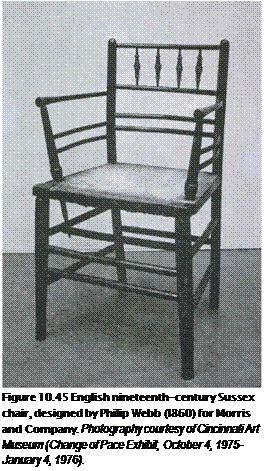By the end of the nineteenth century, Paris was indisputably the center of European furniture production. Furniture fabricated in Paris was typically well finished, with high-quality
workmanship. Chair frames were often made of walnut due to the wood’s stability and workability. By the 1880s, there were approximately 17,000 furniture workers in Paris, 2,000 of them fabricating the best and most expensive pieces (meubles de luxe), 14,000 making cheaper furnishings (meubles courants), and another 500 (trdleurs), whose job was to deliver their finished pieces around to the retail outlets. The huge Parisian furniture industry serviced almost 1,200 retailers, of which 50 were selling meubles de luxe. Despite the enormous number of furniture pieces being produced and fabricators making furniture, most designers looked backward, reviving older styles from eras long gone.
Italy remained a group of small city-states up to the mid-1800s but began to move toward nationhood with the Exposizione dei Protti Dell’Industria Francesca at Perugia. The Italians continued to emulate Renaissance carvings and styles almost to perfection. It was not until the highly personalized work of the Milanese furniture designer Carlo Bugatti (1856-1940) and the unification of Italy in 1879 that a new Italian style emerged. Though Bugatti’s work featured unusual materials and non-Western motifs combined in a personal style, he designed and fabricated an enormous volume of furniture for wealthy Milanese for nearly 30 years before moving to Paris and focusing the remainder of his career on painting. His close association with art was typical of the northern Italians. Italy’s global influence on furniture design would emerge later in the twentieth century, when artigiani (craftspeople) and machine production technologies worked successfully together.
In the 1880s and 1890s, a Moorish influence arose in Europe. Due to the associations with harems and coffee shops, the impact of Moorish furniture on Europe (save for Spain) was confined to semipublic spaces such as smoking and billiard rooms.
In the United States, lavish, deeply buttoned upholstered furniture in eclectic styles became popular in the form of three-seat sofas (Figure 10.44) and love seats. This furniture type developed during the Victorian era. It became an important piece for families, especially with young girls and a chaperone entertaining prospective suitors.
New markets, new products, and expanded trade were factors that created the unprecedented availability of furniture styles at the end of the nineteenth century. Furniture designs
|
Figure 10.44 American sofa, upholstered, Mitchell & Rammelsberg Furniture Co. from Cincinnati, Ohio (established 1847, closed 1881). It is an eclectic mixture of Turkish and Japanese influences. Photography courtesy of Cincinnati Art Museum, Henry Meis Endowment. Accession No. 1987.63.1. |
 oriented to the emerging middle class looked similar to those fabricated a century before by hand for the ruling class. Taste had begun to pass from the palace to the parlor. Designers and consumers began to explore new ideas, seeking some of the lost qualities in craft from the previous century. As the revival period came to a close, the lack of quality in furniture was noticeable when viewed as a whole. As a consequence, there arose a demand for better workmanship, which in turn opened the door for a revival in craft and design.
oriented to the emerging middle class looked similar to those fabricated a century before by hand for the ruling class. Taste had begun to pass from the palace to the parlor. Designers and consumers began to explore new ideas, seeking some of the lost qualities in craft from the previous century. As the revival period came to a close, the lack of quality in furniture was noticeable when viewed as a whole. As a consequence, there arose a demand for better workmanship, which in turn opened the door for a revival in craft and design.




